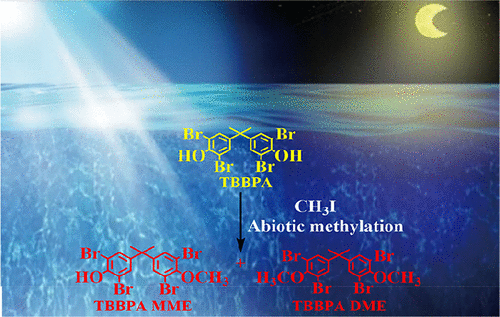当前位置:
X-MOL 学术
›
Environ. Sci. Technol. Lett.
›
论文详情
Our official English website, www.x-mol.net, welcomes your feedback! (Note: you will need to create a separate account there.)
Abiotic Methylation of Tetrabromobisphenol A (TBBPA) with the Occurrence of Methyl Iodide in Aqueous Environments
Environmental Science & Technology Letters ( IF 10.9 ) Pub Date : 2019-08-07 , DOI: 10.1021/acs.estlett.9b00445 Xingwang Hou 1, 2 , Wenqian Kong 1, 2 , Xiaoyun Wang 1, 2 , Yanwei Liu 1, 2 , Weifang Chen 1, 2 , Jiyan Liu 1, 2 , Jerald L. Schnoor 3 , Guibin Jiang 1, 2
Environmental Science & Technology Letters ( IF 10.9 ) Pub Date : 2019-08-07 , DOI: 10.1021/acs.estlett.9b00445 Xingwang Hou 1, 2 , Wenqian Kong 1, 2 , Xiaoyun Wang 1, 2 , Yanwei Liu 1, 2 , Weifang Chen 1, 2 , Jiyan Liu 1, 2 , Jerald L. Schnoor 3 , Guibin Jiang 1, 2
Affiliation

|
Tetrabromobisphenol A (TBBPA) is the most widely used brominated flame retardant in the world. Its biotic methylation products, tetrabromobisphenol A mono- and dimethyl ether (TBBPA MME and TBBPA DME, respectively), are frequently detected in the environment, but the importance of abiotic methylation reactions of TBBPA in the environment is not known. In this study, the methylation of TBBPA mediated by methyl iodide (CH3I), a ubiquitous compound in aqueous environments, was investigated in simulated waters in the laboratory. It was found that abiotic methylation occurred under both light and dark conditions and was strongly affected by the pH, temperature, and natural organic matter concentration of the water. Abiotic methylation was further verified in natural river water, and the yield of TBBPA MME mediated abiotically by CH3I was much greater than that of biotic methylation. According to our calculations and by comparison of the activation energies (Ea) for the abiotic methylation of TBBPA and the other four typical phenolic contaminants and/or metabolites (bisphenol A, triclosan, 5-OH-BDE-47, and 4′-OH-CB-61) mediated by CH3I, those phenolic compounds all show great methylation potentials. The results indicate a new abiotic pathway for generating TBBPA MME and TBBPA DME from TBBPA, and they also confirm the potentials for abiotic methylation of other phenolic contaminants in aqueous environments.
中文翻译:

在水环境中四溴双酚A(TBBPA)的非生物甲基化反应
四溴双酚A(TBBPA)是世界上使用最广泛的溴化阻燃剂。其生物甲基化产物,四溴双酚A单和二甲醚(分别为TBBPA MME和TBBPA DME),在环境中经常被检测到,但是尚不知道TBBPA在环境中的非生物甲基化反应的重要性。在这项研究中,甲基碘(CH 3I)是在水性环境中普遍存在的化合物,已在实验室模拟水中进行了研究。发现非生物甲基化在明暗条件下均发生,并且受到水的pH值,温度和天然有机物浓度的强烈影响。在天然河水中进一步证实了非生物甲基化,CH 3 I非生物介导的TBBPA MME的产率比生物甲基化的产率高得多。根据我们的计算和通过活化能(比较Ë一个),用于TBBPA的非生物甲基化和其它四个典型酚污染物和/或代谢物(双酚A,三氯生,5-OH-BDE-47,和4'- CH 3介导的OH-CB-61)I,那些酚类化合物都显示出很大的甲基化潜力。结果表明,从TBBPA产生TBBPA MME和TBBPA DME的非生物途径,也证实了水性环境中其他酚类污染物的非生物甲基化潜力。
更新日期:2019-08-07
中文翻译:

在水环境中四溴双酚A(TBBPA)的非生物甲基化反应
四溴双酚A(TBBPA)是世界上使用最广泛的溴化阻燃剂。其生物甲基化产物,四溴双酚A单和二甲醚(分别为TBBPA MME和TBBPA DME),在环境中经常被检测到,但是尚不知道TBBPA在环境中的非生物甲基化反应的重要性。在这项研究中,甲基碘(CH 3I)是在水性环境中普遍存在的化合物,已在实验室模拟水中进行了研究。发现非生物甲基化在明暗条件下均发生,并且受到水的pH值,温度和天然有机物浓度的强烈影响。在天然河水中进一步证实了非生物甲基化,CH 3 I非生物介导的TBBPA MME的产率比生物甲基化的产率高得多。根据我们的计算和通过活化能(比较Ë一个),用于TBBPA的非生物甲基化和其它四个典型酚污染物和/或代谢物(双酚A,三氯生,5-OH-BDE-47,和4'- CH 3介导的OH-CB-61)I,那些酚类化合物都显示出很大的甲基化潜力。结果表明,从TBBPA产生TBBPA MME和TBBPA DME的非生物途径,也证实了水性环境中其他酚类污染物的非生物甲基化潜力。



























 京公网安备 11010802027423号
京公网安备 11010802027423号